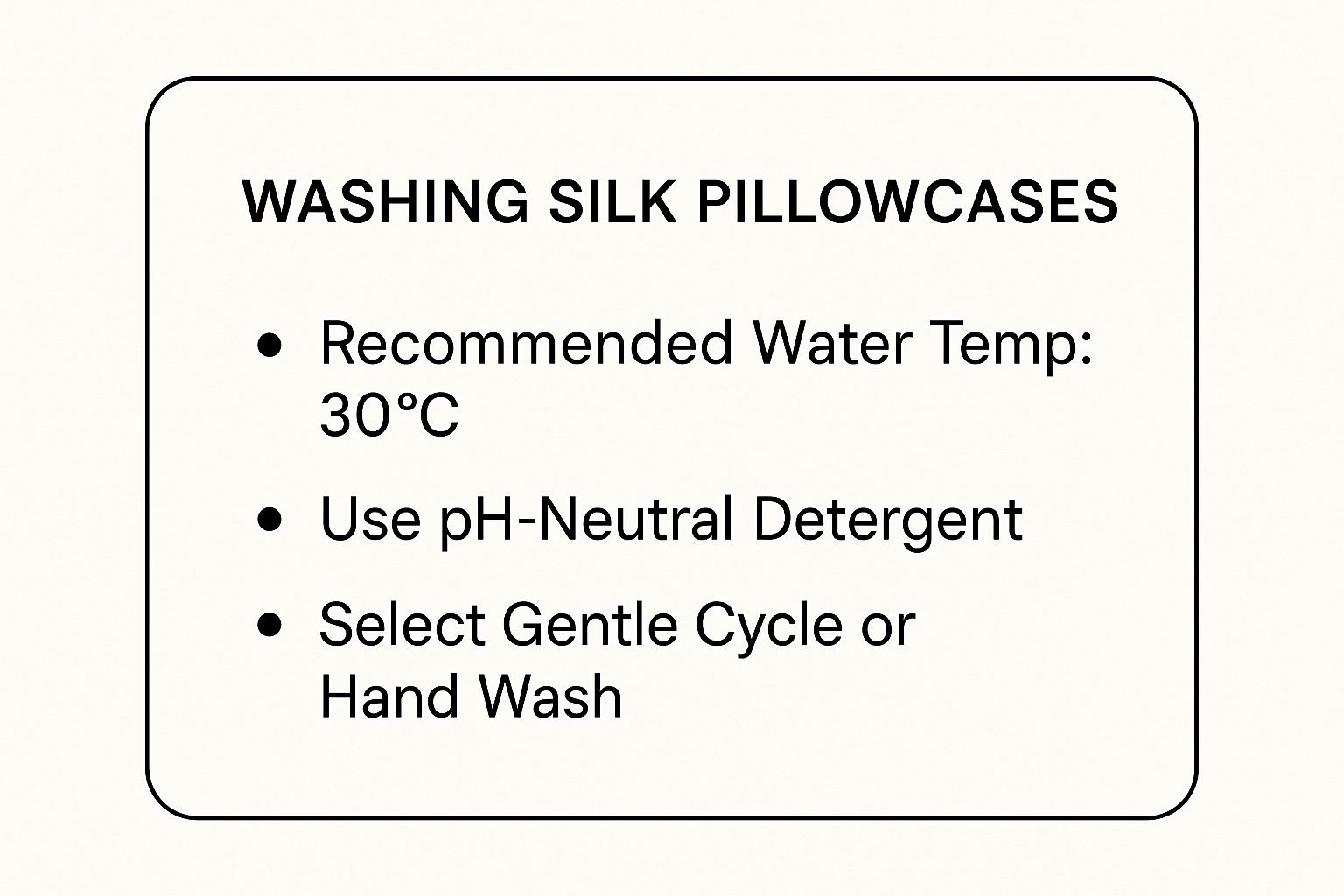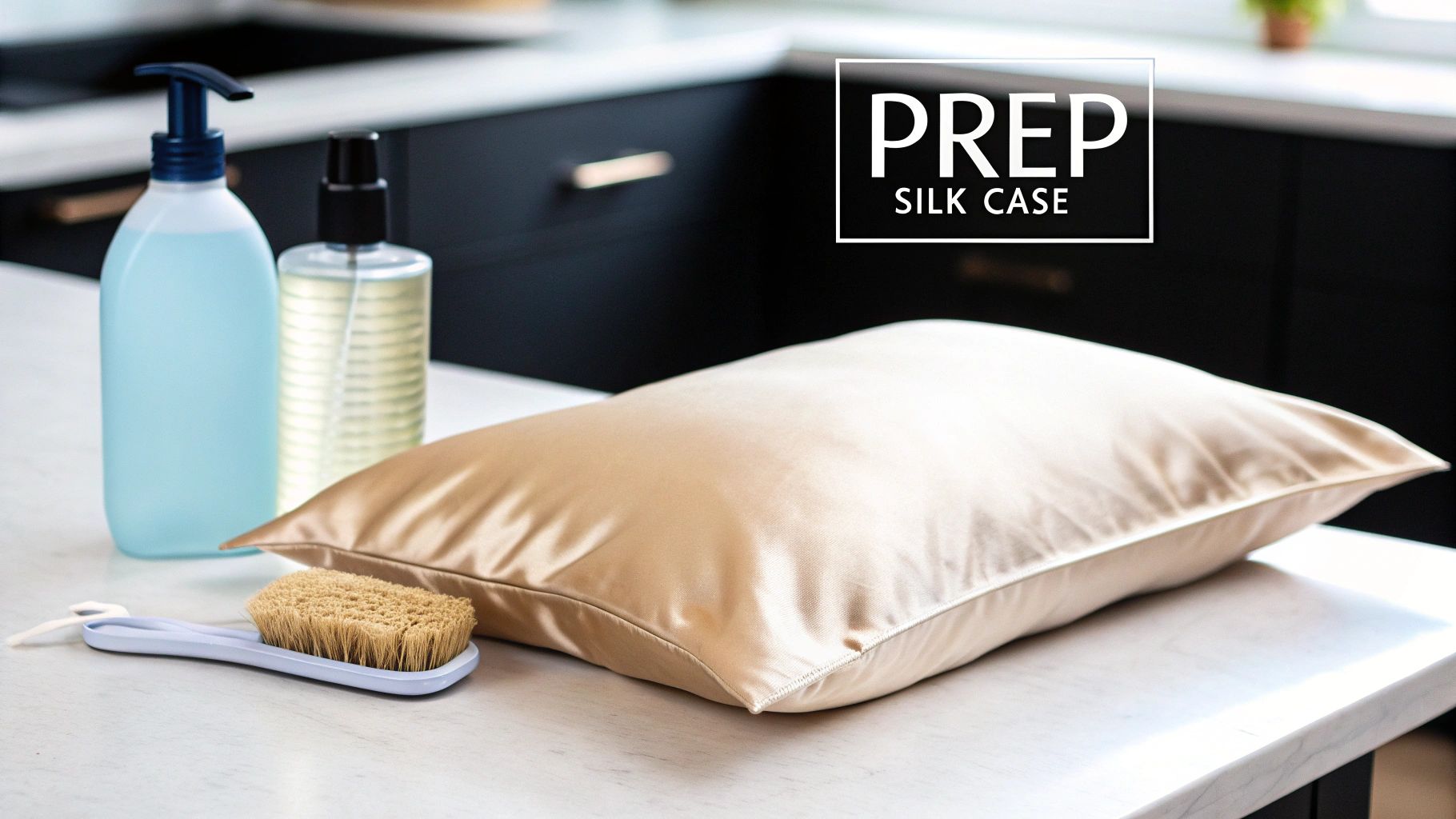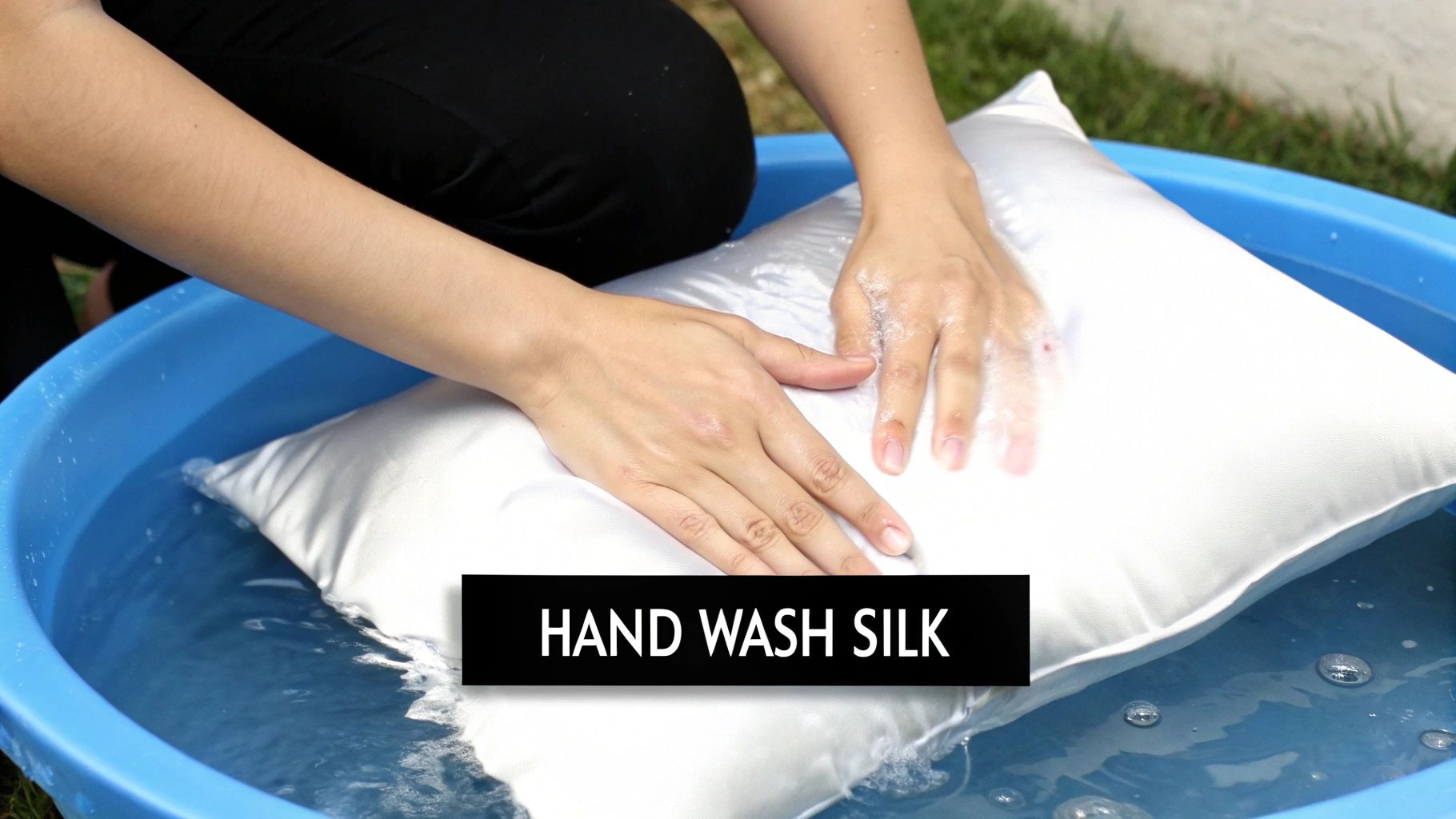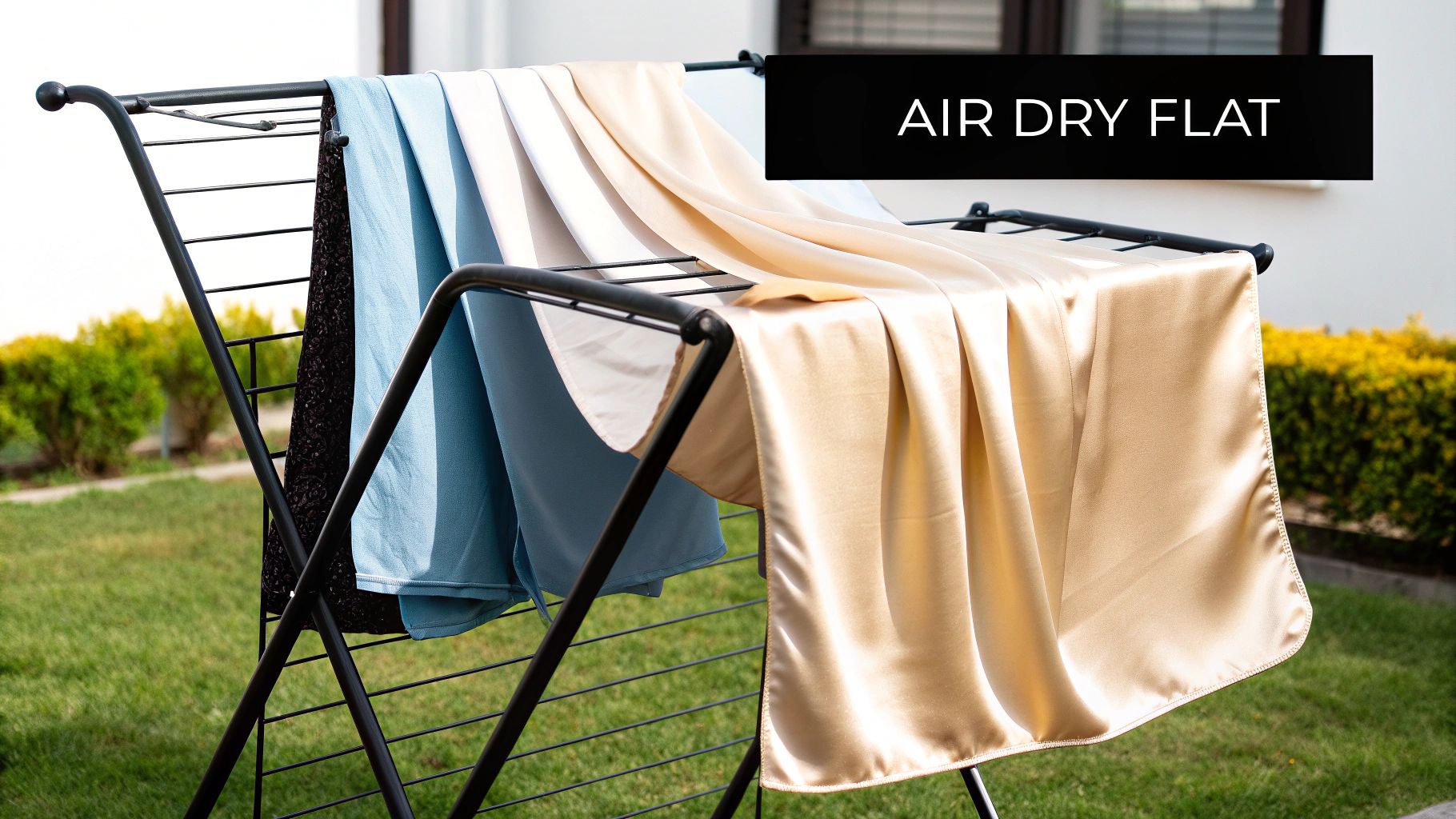Ever held off washing a new silk pillowcase, worried you might ruin its luxurious feel? It’s a common fear, but the truth is, washing silk is surprisingly simple when you know the right technique. Learning how to wash silk pillowcases correctly is the key to preserving their signature softness and shine for years to come.
The secret? Gentle handling is everything. For ultimate protection, a quick hand wash in cool water with a pH-neutral detergent is best. But if you're short on time, your washing machine can do the job safely—as long as you use a delicate cycle and a protective mesh bag.
Your Quick Guide to Washing Silk Pillowcases
Properly washing your silk pillowcase isn't just about cleanliness; it's about protecting your investment. Silk is a natural protein fibre, making it incredibly strong yet delicate. Its biggest enemies are high heat and harsh chemicals, which can quickly degrade the fabric, causing it to lose its lustre and softness.
This guide will show you the safest methods, whether you choose a careful hand wash or the convenience of a machine. Getting this right means your pillowcase will continue to deliver all its benefits, from reducing hair frizz to being kinder on your skin. Research from the Journal of Cosmetics, Dermatological Sciences and Applications highlights silk's smooth surface, which reduces friction and moisture loss from the skin overnight.

As this simple visual shows, success comes down to three things: cool water, the right detergent, and a gentle washing action.
While hand washing remains the gold standard, many modern silks are designed for convenience. You can learn more about the durability of modern silk to see how far the fabric has come.
Hand Washing vs. Machine Washing: A Quick Comparison
Deciding between hand and machine washing is a balance between fabric care and your schedule. This table breaks down the pros and cons to help you choose.
| Method | Best For | Pros | Cons |
|---|---|---|---|
| Hand Washing | Maximum fabric preservation and longevity. Ideal for very delicate or expensive silk. | The gentlest method, giving you full control to preserve the silk's natural lustre and feel. | More time-consuming and requires hands-on effort. |
| Machine Washing | Convenience and saving time, especially for durable, modern silk pillowcases. | Fast and requires minimal effort, perfect for busy laundry days. | Higher risk of snags or damage without a mesh bag and the correct settings. |
Ultimately, both methods work well when done correctly. If you have the time, hand washing is the safest bet. If not, a careful machine wash will get the job done without drama.
Getting Your Silk Ready for a Perfect Wash

Before your silk pillowcase touches water, a little prep work makes all the difference. This preparation is a key part of mastering how to wash silk pillowcases and keeping them looking brilliant.
First, always read the care label. It’s a simple but vital step, as some silk blends or dyes may have specific instructions.
Dealing with Stains and Protecting the Fibres
If you spot a stain from makeup or skincare, treat it before washing. Dab a small amount of pH-neutral, silk-friendly detergent directly onto the spot. Let it sit for 5-10 minutes to gently lift the stain without any harsh scrubbing. For more tips on looking after your bedding, our guide on making your bedding last longer has great advice.
Next, and most importantly, turn your pillowcase inside out. This isn't just a suggestion—it's essential for protecting the lustrous outer side from friction and snags during the wash. Shielding the side that touches your skin and hair preserves the very reason you invested in silk in the first place.
The Gentle Art of Hand-Washing Your Silk
For the best long-term care, hand-washing is your go-to method. It might sound fussy, but it's a simple ritual that protects your delicate silk fibres.
First, fill a clean basin or sink with cool water, at or below 30°C (86°F). Any warmer can damage the silk and dull its natural sheen. To see why this is so important, you can discover more insights about Australian silk care standards.
Creating the Perfect Soapy Solution
Add just a few drops of a pH-neutral, enzyme-free liquid detergent made for delicates. Swirl it gently to mix.
Submerge your pillowcase and let it soak for a maximum of five minutes—that’s all it needs to lift away oils and dirt. Unlike washing everyday cottons, a lighter touch is required, a principle we also cover in our essential guide on washing down quilts.
Gently swish the pillowcase through the water. Imagine pressing the water through the fabric rather than scrubbing it. Avoid rubbing the silk against itself to prevent weakening the fibres.
Rinsing and Finishing
Never twist or wring out your silk pillowcase. This harsh motion can stretch and snap the delicate threads permanently.
Instead, drain the soapy water and refill the basin with fresh, cool water. Swish the pillowcase to rinse away suds, repeating until the water is clear. This ensures all detergent residue is removed, leaving it perfectly clean.
Using a Washing Machine Without the Worry

While handwashing is ideal, life gets busy. You can use your washing machine safely by following a few simple rules, blending modern convenience with the delicate touch silk needs.
First, always use a mesh laundry bag. This is non-negotiable. It acts as a protective shield, preventing snags and abrasion from the machine's drum or other items.
Nailing the Settings and Supplies
Once your pillowcase is turned inside out and zipped into its mesh bag, it's ready for the machine. Use these settings for the safest wash:
- Choose the gentlest cycle: Opt for 'delicates,' 'hand wash,' or a 'silk' setting. These cycles use minimal agitation.
- Lower the spin speed: Set the spin to the lowest speed possible to avoid stretching or weakening the fibres.
- Use the right detergent: Stick with a specialised, pH-neutral detergent for silk. Never use fabric softener, as it coats the fibres and ruins their natural breathability.
Mastering how to wash silk pillowcases in the machine is this straightforward. Follow these steps for beautifully clean silk without the worry.
The Flawless Finish: How to Dry Your Silk Pillowcase
How you dry your silk pillowcase is just as important as how you wash it. One wrong move can undo all your careful work.
The golden rule: never put silk in a tumble dryer. The intense heat will shrink the fabric, damage the delicate fibres, and leave your glossy pillowcase feeling stiff and dull.
First, remove excess water. Lay the damp pillowcase flat on a clean, thick towel. Roll the towel up with the pillowcase inside, pressing gently. This absorbs most of the moisture without harsh wringing that can snap the fine threads.
The Best Way to Air-Dry
Once pressed, it's time to air-dry. You have two good options:
- Lay it flat on a mesh drying rack or another dry towel.
- Place it on a padded, non-slip hanger. Avoid wooden hangers that could transfer colour.
Keep the pillowcase away from direct sunlight and heat sources like radiators, as UV rays can fade colours and weaken the fabric. We cover more small tricks like this in our guide to common bedding questions.
For a truly crisp, wrinkle-free finish, iron while the pillowcase is still slightly damp. Use your iron's coolest setting ('silk') and press on the reverse, matte side to protect the sheen.
Pro Tips for Long-Lasting Silk Care

Once you've mastered washing and drying, a few extra tricks will keep your silk pillowcases beautiful for years. It's about actively preserving the fabric, not just cleaning it.
For an oily stain from a night cream, try this before washing: sprinkle a little cornflour on the spot. Let it sit for an hour to absorb the oil, then gently brush it off.
The Art of Preservation
True long-term care means reducing daily stress on the silk fibres.
- Chlorine Bleach is the Enemy: This is the most important rule. Bleach will destroy silk fibres, causing them to yellow and disintegrate. Use a specialised, silk-safe stain remover instead.
- Rotate Your Pillowcases: Having at least two silk pillowcases in rotation is a game-changer. Swapping them regularly halves the wear and tear on each one, extending their life significantly.
By adopting these small habits, you’re not just cleaning your pillowcase—you’re protecting your investment so every night feels as luxurious as the first.
Your Silk Care Questions Answered
It's normal to have questions when learning how to look after silk. Getting the routine right is the secret to lasting luxury.
How Often Should I Wash My Silk Pillowcase?
For optimal skin and hair benefits, wash your silk pillowcase once a week. This prevents a buildup of natural oils, skin cells, and skincare products, which can clog pores and degrade the silk fibres. If you use heavy night creams or hair oils, consider washing it twice a week.
My Silk Feels Stiff After Washing—What Happened?
A stiff feeling is usually caused by soap residue or drying too quickly in direct heat. Ensure you rinse thoroughly in cool water until no suds remain.
If it's still stiff, hard water minerals could be the culprit. A splash of distilled white vinegar (about a quarter cup) in the final rinse acts as a natural softener, dissolving residue and restoring softness.
What is the Best Detergent for Silk?
Always use a liquid detergent made for delicates or silk that is pH-neutral and enzyme-free. Standard detergents contain enzymes that break down protein stains but will also damage silk, which is a protein fibre. Avoid powdered detergents, bleach, and conventional fabric softeners.
Many of these principles apply to other natural fibres. If you're curious, you might find answers in our guide on frequently asked questions about bamboo bedding.
Experience the Luxury of Silk
Caring for silk is a simple act that rewards you with lasting comfort and beauty. Now that you know how to wash silk pillowcases like a pro, you can enjoy their benefits every single night without worry.
Ready to transform your sleep? Sienna Living offers luxurious, high-quality bedding designed for the ultimate sleep experience.

